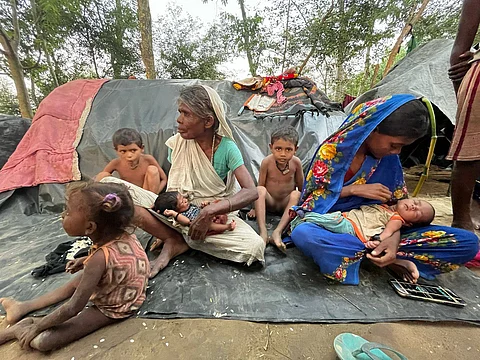

The climate crises are not gender neutral. Women and children are 14 times more likely than men to die in a disaster, notes a scoping study titled, How Does Climate Change Impact Women and Children Across Agroecological Zones in India, by the Union Ministry of Women And Child Development (WCD).
Women often face higher risks and greater burdens from the impacts of climate change in situations of poverty, due to their existing roles, responsibilities and cultural norms.
But, despite the disproportionate burden of disasters on women, there is a lack of gender disaggregated data on climate-induced extreme weather events in India, which is crucial for developing policies and response plans to manage these disasters better.
For instance, often during a disaster, even simple data such as how many women died or got injured in a disaster, their age groups, their family members, their earnings, their native homes, etc are not available.
“Women and girls are most vulnerable to disasters globally. For instance, climate-induced disasters disrupt agriculture and affect food security, and most women in rural areas are involved in farming activities for their livelihoods. There are data gaps,” said Susan Ferguson, India Representative of UN Women.
“We need gender disaggregated data on disasters so that right policies can be shaped and budgetary allocations made,” Ferguson pointed out during a one-day international workshop on ‘Women’s Role in Disaster Risk Reduction Landscape: Domestic and Global Perspectives’, organised by National Disaster Management Authority (NDMA) in partnership with UN Women, on March 25, in New Delhi.
Acknowledging how women are affected far more in disasters, Rajendra Singh, Member, NDMA, said that women are not just ‘beneficiaries’ of various government programmes. “We see women as powerful agents of change. They can play a leadership role in community-driven approaches to disaster management. We are working towards making women’s role central to disaster programmes and policies,” he added.
Prime Minister Narendra Modi’s Ten Point Agenda on Disaster Risk Reduction (DRR) also stresses that “women’s leadership and greater involvement should be central to disaster risk management”. It notes that “women are generally seen as vulnerable to disasters. But women can play an important role in disaster risk reduction at the household, society, community and beyond.”
India ranked 138 out of 185 countries in 2023 in the ND-GAIN (Notre Dame Global Adaptation Initiative) rankings, underscoring its vulnerability to climate change. Climate change effects include drought, floods, extreme weather events, rising disease rates, and heightened food and water insecurity that affects billions of global poor, with women comprising the majority among them.
Twenty seven out of 35 states and Union Territories in the country are highly vulnerable to hydro- meteorological disasters like cyclones, floods and droughts, noted the scoping study by WCD. While the north-eastern and eastern zones of the country are highly exposed to extreme floods, the western and central zones are more vulnerable to drought-like conditions. India’s agriculture sector relies on the monsoon, however, the rainfall patterns have become erratic (more precipitation but lesser number of rainy days) with longer drought spells.
“Women are often involved in informal livelihoods and do not have access to formal finance. During disasters and disruptions, the losses that women face — economic or noneconomic — do not get accounted for, thus not capturing the real impact of disasters,” said Somabha Mohanty, National Lead - Gender, Resilience, and DRR, with UN Women.
“Gender disaggregated data is the need of the hour,” she added.
Mrinalini Shrivastava, Director with NDMA, informed that gender-responsive data collection was the mandate given by the Government of India and NDMA was committed towards it. “We are already training state-level officials on why such data is important and how it has to be collected. This data is important for budgeting and resource allocation,” she said.
Odisha has already taken a lead in this direction. Meghanad Behera, Senior DRR Consultant with Odisha State Disaster Management Authority (OSDMA), informed that the eastern India state was mainstreaming gender in all its DRR policies and programmes with support from the United Nations Population Fund (UNFPA).
“We have created a gender cell at OSDMA, possibly the first Indian state to do so. We are also setting up gender cells at district-level, and training department officials and administrative staff to collect gender-based data for disasters and extreme weather events. We have already set up 21 district-level gender cells in the state,” said Behera. “Odisha state is also training village youth in disaster response and setting up a Village Level Task Force of 10 youth in each village. This year we plan to train 10,000 such village volunteers,” he added.
Rajendra Singh informed that of the 100,000 Aapda Mitras in the country, over 20,000 were women. NDMA has been implementing a central sector scheme namely Aapda Mitra to provide the community volunteers with the skills to respond to their community’s immediate needs in the aftermath of a disaster thereby enabling them to undertake basic relief and rescue tasks.
Singh also referred to a novel heat micro-insurance programme of Self Employed Women’s Association (SEWA) in Ahmedabad, Gujarat, which protects informal female workers during heatwave periods by replacing income lost due to extreme heat days.
“Whenever women are involved in any programme, they bring with them a strong sense of resilience. We need to involve more and more women at the grassroots and train them for DRR assessment, resource mapping at community level, and make them a part of early warning systems,” he said.
Shrivastava concluded the workshop by informing that the NDMA would push for gender-sensitive DRR programmes and policies, and will also launch a pilot on gender-disaggregated data collection.
“We will also scale up training programmes on DRR in rural areas, including rural reporters; and bring out a compendium of best practices in this sector,” she said.